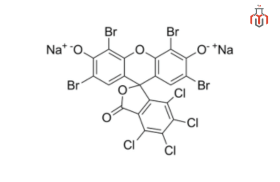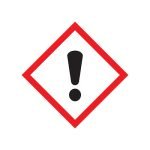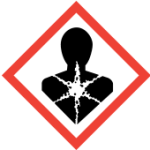
Phloxine B (Acid Red 92) is a water-soluble red dye. It is derived from fluorescein with bromine and chlorine substitutions. Its molecular structure has four Bromine atoms on the xanthene ring and four chlorine atoms on the carboxyphenyl ring. Besides industrial applications, Phloxine B is used as an antimicrobial agent, a viability dye, and a biological stain. It is commonly used in hematoxylin-phloxine-saffron (HPS) staining to color the cytoplasm and connective tissue in red shades.

CAS No.: 18472-87-2
Synonyms: Cyanosin; Cyanosine; Eosine bluish; Eosine Blue; Cyanosin B; Eosin Blue; Phloxine P; Phloxin B; Eosine I Bluish; Acid red 92; C.I. 45410; D & C Red no. 2
Resources: Biological Stains | Classification, Examples & Uses
| Physical Properties | |
| Chemical formula | C20H2Br4Cl4Na2O5 |
| IUPAC name | disodium;2′,4′,5′,7′-tetrabromo-4,5,6,7-tetrachloro-3-oxospiro[2-benzofuran-1,9′-xanthene]-3′,6′-diolate |
| Molecular weight | 829.6 g/mol |
| Solubility | Soluble in Water, Ethanol, DMSO, and Dimethyl formamide (DMF) |
| pH | 9.7 at 20°C |
| Density | 0.871 g/cm3 at 20°C |
| Chemical Properties | |
| Color | Red Brown |
| State | Solid powder |
| Melting point | >250°C |
| λmax | 548nm, 510nm |
| LogP | 0.165 at 25℃ |
In countries like Japan, it is mostly used in making food items like cakes, sausages, confectionery products, and cookies. However, it is not recommended to use in all types of beverages and candies with a pH >4.5.
Acid Red 92 is used as biological staining to identify and highlight cellular structures. It is also used as spectrophotometry and as a pH indicator.
| Pictograms : |   |
| Hazard Statements : | H302: Harmful if swallowed. H319: Causes serious eye irritation. H373: May cause damage to organs through prolonged or repeated exposure. H412: Harmful to aquatic life with long lasting effects. |
| Precautionary statements : | P260: Do not breathe dust/fume/gas/mist/vapors/spray. P264: Wash thoroughly after handling. P270: Do not eat, drink or smoke when using this product. P273: Avoid release to the environment. P280: Wear eye protection / face protection. P301+P312: If swallowed: Call a poison center/doctor if you feel unwell. P330: Rinse mouth. P305+P351+P338: If in eyes: Rinse cautiously with water for several minutes. Remove contact lenses, if present and easy to do. Continue rinsing. P314: Get medical advice/attention if you feel unwell. P337+P313: If eye irritation persists: Get medical advice/attention. P501: Dispose of contents/container in accordance with local/regional/national/ international regulations. |
Phloxine B (Acid Red 92) is a water-soluble red dye. It is derived from fluorescein with bromine and chlorine substitutions. Its molecular structure has four Bromine atoms on the xanthene ring and four chlorine atoms on the carboxyphenyl ring. Besides industrial applications, Phloxine B is used as an antimicrobial agent, a viability dye, and a biological stain. It is commonly used in hematoxylin-phloxine-saffron (HPS) staining to color the cytoplasm and connective tissue in red shades.

CAS No.: 18472-87-2
Synonyms: Cyanosin; Cyanosine; Eosine bluish; Eosine Blue; Cyanosin B; Eosin Blue; Phloxine P; Phloxin B; Eosine I Bluish; Acid red 92; C.I. 45410; D & C Red no. 2
Resources: Biological Stains | Classification, Examples & Uses
| Physical Properties | |
| Chemical formula | C20H2Br4Cl4Na2O5 |
| IUPAC name | disodium;2′,4′,5′,7′-tetrabromo-4,5,6,7-tetrachloro-3-oxospiro[2-benzofuran-1,9′-xanthene]-3′,6′-diolate |
| Molecular weight | 829.6 g/mol |
| Solubility | Soluble in Water, Ethanol, DMSO, and Dimethyl formamide (DMF) |
| pH | 9.7 at 20°C |
| Density | 0.871 g/cm3 at 20°C |
| Chemical Properties | |
| Color | Red Brown |
| State | Solid powder |
| Melting point | >250°C |
| λmax | 548nm, 510nm |
| LogP | 0.165 at 25℃ |
In countries like Japan, it is mostly used in making food items like cakes, sausages, confectionery products, and cookies. However, it is not recommended to use in all types of beverages and candies with a pH >4.5.
Acid Red 92 is used as biological staining to identify and highlight cellular structures. It is also used as spectrophotometry and as a pH indicator.
| Pictograms : |   |
| Hazard Statements : | H302: Harmful if swallowed. H319: Causes serious eye irritation. H373: May cause damage to organs through prolonged or repeated exposure. H412: Harmful to aquatic life with long lasting effects. |
| Precautionary statements : | P260: Do not breathe dust/fume/gas/mist/vapors/spray. P264: Wash thoroughly after handling. P270: Do not eat, drink or smoke when using this product. P273: Avoid release to the environment. P280: Wear eye protection / face protection. P301+P312: If swallowed: Call a poison center/doctor if you feel unwell. P330: Rinse mouth. P305+P351+P338: If in eyes: Rinse cautiously with water for several minutes. Remove contact lenses, if present and easy to do. Continue rinsing. P314: Get medical advice/attention if you feel unwell. P337+P313: If eye irritation persists: Get medical advice/attention. P501: Dispose of contents/container in accordance with local/regional/national/ international regulations. |
Phloxine B is a synthetic red dye used in industries, laboratories, and medical applications. It is commonly used as a biological stain, viability dye, and antimicrobial agent
Phloxine B is primarily used as a dye for coloring drugs, cosmetics, and food. It is also employed in biological staining procedures to highlight cellular components and assess cell viability, particularly in yeasts where it stains dead cells.
Phloxine B stains dead cells by penetrating their compromised membranes and binding to intracellular components.
It is irritating to the eyes and skin. It is also harmful to aquatic organisms.
Phloxine B is highly soluble in water and moderately soluble in ethanol. Its water solubility allows it to function effectively as a biological stain and antimicrobial agent.
Store Acid Red 92 in a cool, dry, and well-ventilated area, away from direct sunlight and strong oxidizing agents.